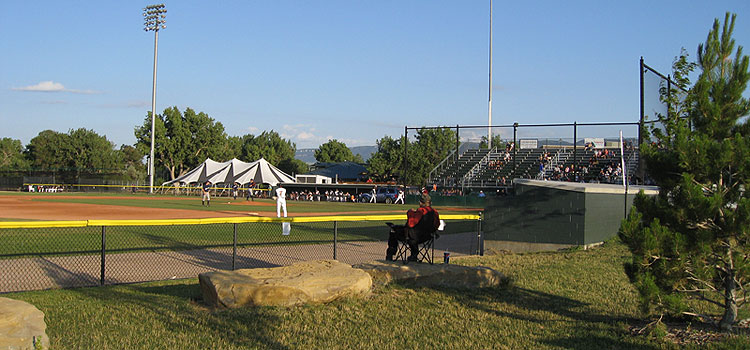
|
Tim Smight, a writer for USA Today, contacted me at the end of January and wanted to know if I could select 10 minor league ballparks for a piece that ended up being published under the headline of "10 great places for a baseball pilgrimage." Given the title of the article, he thought I'd be the appropriate expert. I was honored and obliged by selecting a list of 10 ballparks that fit the criteria that USA Today was searching for. Specifically, the list needed to be geographically diverse and it didn't have to be the "10 best minor league parks -- just 10 that are great destinations for travelers who enjoy baseball." After making my selections, Tim was interested to know why I thought each of them was "special, unique and appealing," given that I had nearly 215 minor league parks to choose from. Here is my response, with some "value added" tourist information, and you can see the end result online at USA Today, which is also how the list appeared in print on page 6D of the "Life" section on Friday, April 2 as part of the newspaper's weekly "10 Great" travel series.
Slightly east of downtown Oklahoma City, the turn-of-the-century warehouse district known as Bricktown was revitalized exactly a century after it was established thanks to the opening of Bricktown Ballpark and the ensuing $3.1 billion of private investment that followed its construction. The ballpark is a nice enough place to watch a game, but it's the brick facade and distinctively Oklahoman display of baseball history found inside and outside of AT&T Bricktown Ballpark that make it special. Each of the ballpark's three entrances and corresponding plazas are named after an impressive trifecta of the state's native (Mickey Mantle, Johnny Bench) and adopted (Warren Spahn) sons, while bronze busts of seven other famous baseball playing Oklahomans line the walkway near The Mick's plaza, across from which is Mickey Mantle's Steakhouse. Many rank and file Oklahomans that played in the majors are remembered along the walls of the ballpark's roomy concourse and just about every fan in the grandstand enjoys a brick building backdrop or view of the OKC skyline. Bricktown, the neighborhood, has over two dozen clubs and restaurants and the San Antonio Riverwalk-inspired Bricktown Canal runs through it. What it all ads up to is an area awash with pre- or post-game options that is the envy of some major league cities and a ballpark that is the envy of most minor league towns.
Camden Yards gets most of the credit, but the pioneering concept that became the de facto trend of building a baseball-only stadium within the heart of a city's downtown actually originated in Buffalo four years prior to the Orioles' much-lauded retro-styled ballpark opened in Baltimore. Each were designed by the same architectural firm, now called Populous, that revolutionized the facilities from watch the game is watched. In Buffalo, that meant building a new ballpark so that it blended with the historical buildings already found in the city's center, then adding some creative local flair by taking the 500-lb. bronze doors from the original Buffalo Savings Bank building and adding it to the ballpark's signature restaurant, the Pettibones Grille, which is found on the first base side of the park. The Buffalo wing is the food item that will be forever associated with New York's second most populated city, as it was "invented" in 1964 at the nearby Anchor Bar, and every year since 2002 the National Buffalo Wing Festival has been held on Labor Day weekend at Coca-Cola Field, which has a big league feel by no accident as it was designed to be expandable to a capacity of 45,000 so that it could host Major League Baseball, although MLB later opted to expand into other markets instead.
Tourist tip:
One of the greatest urban field of dreams in the nation is found in Toledo, where the world famous (thanks to M*A*S*H ) Mud Hens helped revitalize the city's historic brick-laden Warehouse District when they moved from the suburbs into their downtown ballpark in 2002. Designed to blend in with the buildings that surround it, Fifth Third Field also incorporates a few of the former warehouses in an effective example of adaptive reuse. The ballpark's signature feature, a home run porch called The Roost, is attached to one of the restored warehouses, and the 282 seats contained in it were named the best in the minors by ESPN.com in 2007. This ballpark has a little bit of everything and fans will be wowed by the non-baseball views, as the Toledo skyline dominates the backdrop. Five public art projects commissioned on the ballpark's eight acres contribute to its charm, while the plaza outside of the home plate entrance tells the story of Moses Fleetwood Walker, who in 1884 became the first African American major leaguer when he caught for the Toledo Blue Stockings. Chain and regionally recognized restaurants flank multiple sides of the ballpark, which itself serves up a wide array of tasty treats at its various concession stands and carts. Their offerings are all listed in The Muddy Times, the Mud Hens' free full color game magazine that all ticket holders are entitled to upon entering the ballpark.
The city that's home to the Great American Race also hosts America's pastime, but does so in a much better location than where the famous Daytona International Speedway resides. About three miles east of the race track the home field of the Daytona Cubs stands upon City Island, where it overlooks the Halifax River. The ballpark doesn't just look old; it is old. Built in 1930, it was where Jackie Robinson actually integrated the sport during spring training in 1946, when he and his Montreal Royals played the Brooklyn Dodgers in Daytona Beach after the game was moved from Jacksonville, which like most Florida towns of the time period had strict segregation laws. A year later, Robinson broke the color barrier at the Major League level, winning the inaugural Rookie of the Year award in the process. In 1989, Daytona City Island Ballpark was renamed in Robinson's honor and a statue and exhibits pertaining to him have been erected inside and outside of Jackie Robinson Ballpark, which has been damaged by a few hurricanes over the years that have made repairs more frequent than renovations. Nonetheless, the present day covered grandstand and press box built atop it date to 1962. While it may not be the most comfortable ballpark in use today, few have a more pleasing backdrop, both from a historical and visual standpoint, and Daytona Beach's self-proclaimed world famous beaches are a short drive away.
It's only fitting that a baseball field in the Bluegrass State be sodden with Kentucky Bluegrass and only natural that a team that plays in Louisville be known as the Bats, as the Louisville Slugger bat factory is a mere 10 blocks from the ballpark that bears its name. Built upon the banks of the Ohio River, the home of the Louisville Bats baseball team is fronted by a restored late 19th century brick warehouse that serves as the main entrance. Depending on where you sit, you can glimpse the downtown skyline or the cantilevered bridge that carries I-65 over the river that serves as the border between Kentucky and Indiana. Perks of the park include a carousel for the kiddies in right field, a berm in left-center, and a concourse that is open to the playing field that it encircles. Noted for its close proximity to the city's popular Waterfront Park, the ballpark is also near two open year-round museums that sports fans will want to visit: Louisville Slugger's and the one found at Churchill Downs that chronicles the history of the iconic Kentucky Derby.
It's the only pro ballpark in the United States’ least populated state and named for former big leaguer Mike Lansing, who grew up in Casper. The team made headlines in 2008 when they began wearing glow-in-the-dark caps, which they sell in their gift shop alongside pennants that can do the same thing. The ballpark is quaint, as it's open-ended beyond the dugouts, and behind each dugout is a wooden party deck (Teton Terrace) from which a bevy of draft brews are served. Drink rails built atop the dugouts give fans the same view - but elevated - as the players in the dugout below. Peering over the right field wall is the "Big Catch" mural. The 20-foot tall mural shows two youngsters watching the game while fishing into the North Platte River, which isn't visible but is a handful of feet beyond the wall. As the seventh smallest ballpark in the minors, Mike Lansing Field is noted for its wide open spaces, just like the state that it resides in, and the flat rocks in the open field field just past the third base dugout provide an interesting vantage point from which to watch the game and chat up the friendly folks attending it.
Tourist tip:
Baseball has been played on the same riverfront grounds of Iowa's third-largest city since 1931, when what's currently called Modern Woodmen Park opened as Municipal Stadium. A major multi-million dollar renovation completed in 2004 gave the ballpark the amenities it lacked and included the construction of an outfield berm, which doubles as flood protection for the previously flood prone stadium that is built upon the banks of the Mississippi River, in which home runs hit to right field often land. The Centennial Bridge that spans the Mighty Mississippi makes for a wonderful backdrop while the corn that grows in the left field corner evokes memories of Field of Dreams, which was filmed in nearby Dyersville, an 88-mile drive to the northwest. Fans can make the pilgrimage to the Field of Dreams Movie Site anytime during the River Bandits' season, as it's open to the public free of charge from 9 a.m. to 6 p.m. from April through November.
California's capital city technically is not home to Sacramento's pro baseball team, but just across the Sacramento River river from it stands Raley Field and the city of West Sacramento, which is where the River Cats play. The two cities are connected by the yellow Tower Bridge, which makes up part of a splendid backdrop that also includes the pyramid shaped Ziggurat Building on West Sacramento's side of the river and the bigger buildings of Sacramento's skyline. Fans of all municipalities are welcome to bring in lawn chairs to sit in the stadium's popular and spacious berm while those of all ages will find something to enjoy in Old Sacramento, the appropriate name for the museum-laded historic district that draws millions of visitors each year to the 28-acre section of Sacramento that has over 50 historic buildings, many of which are now filled with trendy dining and drinking destinations.
Round Rock is where the Dell computer company is headquartered, hence the name of the Austin suburb's ballpark. The team that plays there is owned by Nolan Ryan, who was known as "The Ryan Express," hence the moniker of the team, known as the Round Rock Express. Their ballpark has many big league-style amenities upon its premises, including private suits aplenty, a two-tier Home Run Porch in left field and a 20' x 50' pool in right field. Near the pool is a covered dining area where, as the team says, "fans can feast on good ol' Texas cookin' while watching the ballgame." And fans flock here to watch the ballgame, as the Express have perennially been one of the minors' top draws since their debut deep in the heart of Texas a decade ago. Twenty miles south of the ballpark is Texas's capital city, and not only is Austin home to the state's top lawmakers and flagship university, it's generally regarded as one of the more hip places in the country to hang out.
| |||||||||||||||||||||||||||||
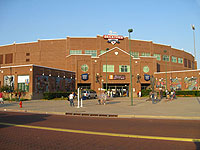
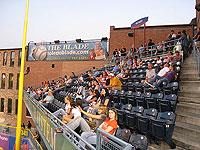
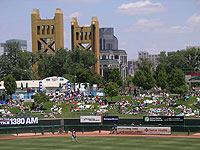
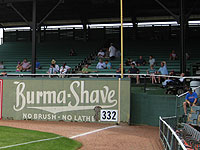 The Birmingham Barons moved out of Birmingham long ago. When they did, they left behind Rickwood Field, which opened in 1910 and becomes the nation's first centenarian pro ballpark this summer, when it hosts the 15th Annual Rickwood Classic. Modeled after Forbes Field, the minor leagues’ first concrete and steel stadium would've met the same fate as Pittsburgh's historic ballpark if not for the Friends of Rickwood, a non-profit organization formed in 1993 to restore Rickwood Field to the glory it enjoyed during the first half of the 20th century. With a vintage hand-operated scoreboard and advertisements of yesteryear preserved on its outfield walls, Rickwood is an authentic 1940’s-era ballpark that's open year round for fans who want to take self-guided tours. But to really experience the ballpark at its finest, make plans to attend the Barons' game there against the Tennessee Smokies on June 2, when both teams will wear throwback uniforms from Rickwood's inaugural decade in celebration of the throwback ballpark's 100th birthday. To experience a contrast of eras, the Barons play the Smokies in their normal home the day before and after the Rickwood Classic in Hoover, the 20 miles away suburb where 22-year old
The Birmingham Barons moved out of Birmingham long ago. When they did, they left behind Rickwood Field, which opened in 1910 and becomes the nation's first centenarian pro ballpark this summer, when it hosts the 15th Annual Rickwood Classic. Modeled after Forbes Field, the minor leagues’ first concrete and steel stadium would've met the same fate as Pittsburgh's historic ballpark if not for the Friends of Rickwood, a non-profit organization formed in 1993 to restore Rickwood Field to the glory it enjoyed during the first half of the 20th century. With a vintage hand-operated scoreboard and advertisements of yesteryear preserved on its outfield walls, Rickwood is an authentic 1940’s-era ballpark that's open year round for fans who want to take self-guided tours. But to really experience the ballpark at its finest, make plans to attend the Barons' game there against the Tennessee Smokies on June 2, when both teams will wear throwback uniforms from Rickwood's inaugural decade in celebration of the throwback ballpark's 100th birthday. To experience a contrast of eras, the Barons play the Smokies in their normal home the day before and after the Rickwood Classic in Hoover, the 20 miles away suburb where 22-year old 